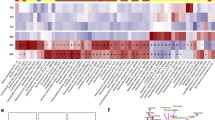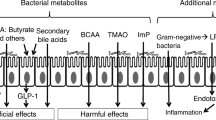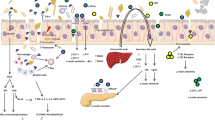Abstract
The ratio of human to bacterial cells in the human body (microbiota) is around 1:1. As a result of co-evolution of the host mucosal immune system and the microbiota, both have developed multiple mechanisms to maintain homeostasis. However, dissociations between the composition of the gut microbiota and the human host may play a crucial role in the development of type 2 diabetes. Metformin, the most frequently administered medication to treat patients with type 2 diabetes, has only recently been suggested to alter gut microbiota composition through the increase in mucin-degrading Akkermansia muciniphila, as well as several SCFA-producing (short-chain fatty acid) microbiota. The gut microbiota of participants on metformin has exerted alterations in gut metabolomics with increased ability to produce butyrate and propionate, substances involved in glucose homeostasis. Thus, metformin appears to affect the microbiome, and an individual’s metformin tolerance or intolerance may be influenced by their microbiome. In this review, we will focus on the effects of metformin in gut microbiota among patients with T2DM.


Similar content being viewed by others
References
Backhed F (2005) Host-bacterial mutualism in the human intestine. Science 307:1915–1920
Gill SR, Pop M, DeBoy RT et al (2006) Metagenomic analysis of the human distal gut microbiome. Science 312:1355–1359
Sender R, Fuchs S, Milo R (2016) Revised estimates for the number of human and bacteria cells in the body. PLoS Biol 14(8):e1002533
Qin J, Li Y, Cai Z et al (2012) A metagenome-wide association study of gut microbiota in type 2 diabetes. Nature 490:55–60
Karlsson FH, Tremaroli V, Nookaew I et al (2013) Gut metagenome in European women with normal, impaired and diabetic glucose control. Nature 498:99–103
Larsen N, Vogensen FK, van den Berg FWJ et al (2010) Gut microbiota in human adults with type 2 diabetes differs from non-diabetic adults. PLoS One 5:e9085
Zhang X, Shen D, Fang Z et al (2013) Human gut microbiota changes reveal the progression of glucose intolerance. PLoS One 8:e71108
Tilg H, Moschen AR (2014) Microbiota and diabetes: an evolving relationship. Gut 63:1513–1521
Forslund K, Hildebrand F, Nielsen T et al (2015) Disentangling type 2 diabetes and metformin treatment signatures in the human gut microbiota. Nature 528:262–266
de la Cuesta-Zuluaga J, Mueller NT, Vanessa Corrales-Agudelo V et al (2017) Metformin is associated with higher relative abundance of mucin-degrading Akkermansia muciniphila and several short-chain fatty acid-producing microbiota in the gut. Diabetes Care 40:54–62
Bennett D (2005) Growing pains for metabolomics. Scientist 19(8):25–28
Pedersen HK, Gudmundsdottir V, Nielsen HB et al (2016) Human gut microbes impact host serum metabolome and insulin sensitivity. Nature 535:376–381
Perry RJ, Peng L, Barry NA et al (2016) Acetate mediates a microbiome-brain-beta-cell axis to promote metabolic syndrome. Nature 534:213–217
Lee H, Ko G (2014) Effect of metformin on metabolic improvement and gut microbiota. Appl Environ Microbiol 80:5935–5943
Shin NR, Lee JC, Lee HY et al (2014) An increase in the Akkermansia spp. population induced by metformin treatment improves glucose homeostasis in diet-induced obese mice. Gut 63:727–735
Napolitano A, Miller S, Nicholls AW et al (2014) Novel gut-based pharmacology of metformin in patients with type 2 diabetes mellitus. PLoS One 9:e100778
Gall WE, Beebe K, Lawton KA et al (2010) α-Hydroxybutyrate is an early biomarker of insulin resistance and glucose intolerance in a nondiabetic population. PLoS One 5:e10883
Bonora E, Cigolini M, Bosello O et al (1984) Lack of effect of intravenous metformin on plasma concentrations of glucose, insulin, C-peptide, glucagon and growth hormone in non-diabetic subjects. Curr Med Res Opin 9:47–51
Bailey CJ, Wilcock C, Scarpello JH (2008) Metformin and the intestine. Diabetologia 51:1552–1553
Sekar S, Chandrasekaran A, Rao U, Sastry TP (2011) Comparison of some of the physicochemical characteristics of type 2 diabetic and normal human bones: a sample study. J Diabetes Complicat 25:187–192
DeFronzo RA, Buse JB, Kim T et al (2016) Once-daily delayed release metformin lowers plasma glucose and enhances fasting and postprandial GLP-1 and PYY: results from two randomised trials. Diabetologia 59:1645–1654
Buse JB, DeFronzo RA, Rosenstock J et al (2016) The primary glucose-lowering effect of metformin resides in the gut, not the circulation: results from short-term pharmacokinetic and 12-week dose-ranging studies. Diabetes Care 39:198–205
Wu H, Esteve E, Tremaroli V et al (2017) Metformin alters the gut microbiome of individuals with treatment-naive type 2 diabetes, contributing to the therapeutic effects of the drug. Nat Med. https://doi.org/10.1038/nm.4345
Gong L, Goswami S, Giacomini KM, Altman RB, Klein TE (2012) Metformin pathways: pharmacokinetic and pharmacodynamics. Pharmacogenet Genomics 22(11):820–827
Dresser MJ, Xiao G, Leabman MK, Gray AT, Giacomini KM (2002) Interactions of N-tetraalkylammonium compounds and biguanides with a human renal organic cation tranporter (hOCT2). Pharm Res 19:1244–1247
Kimura N, Masuda S, Tanihara Y et al (2005) Metformin is a superior substrate for renal organic cation tranporter OCT2 rather than hepatic OCT1. Drug Metab Pharmacokinet 20:379–386
Urakami Y, Nakamura N, Takahashi K et al (1999) Gender differences in expression of organic cation transporter OCT2 in rat kidney. FEBS Lett 461:339–342
Urakami Y, Okuda M, Saito H, Inui K (2000) Hormonal regulation of organic cation transporter OCT2 expression in rat kidney. FEBS Lett 473:173–176
Asaka J, Terada T, Okuda M, Katsura T, Inui K (2006) Androgen receptor is responsible for rat organic cation transporter 2 gene regulation but not for rOCT1 and rOCT3. Pharm Res 23:697–704
Leabman MK, Giacomini KM (2003) Estimating the contribution of genes and environment to variation in renal drug clearance. Pharmacogenetics 13:581–584
Mofo Mato EP, Guewo-Fokeng M, Essop MF, Oroma Owira PM (2018) Genetic polymorphisms of organic cation transporter 1 (OCT1) and responses to metformin therapy in individuals with type 2 diabetes: a systematic review. Medicine 97:27e11349
Barengolts E, Green SJ, Eisenberg Y et al (2018) Gut microbiota varies by opioid use, circulating leptin and oxytocin in African American men with diabetes and high burden of chronic disease. PLoS One 13(3):e0194171
Burton JH, Johnson M, Johnson J, Hsia DS, Greenway FL, Heiman ML (2015) Addition of a gastrointestinal microbiome modulator to metformin improves metformin tolerance and fasting glucose levels. J Diabetes Sci Technol 9:808–814
Brunkwall L, Orho-Melander M (2017) The gut microbiome as a target for prevention and treatment of hyperglycaemia in type 2 diabetes: from current human evidence to future possibilities. Diabetologia 60:943–951
McCreight LJ, Bailey CJ, Pearson ER (2016) Metformin and the gastrointestinal tract. Diabetologia 59:426–435
Henry RR, Frias JP, Walsh B et al (2018) Improved glycemic control with minimal systemic metformin exposure: effects of metformin delayed-release (metformin DR) targeting the lower bowel over 16 weeks in a randomized trial in subjects with type 2 diabetes. PLoS One 13(9):e0203946
Duca FA, Cote CD, Rasmussen BA et al (2015) Metformin activates a duodenal AMPK-dependent pathway to lower hepatic glucose production in rats. Nat Med 21:506–511
Duong JK, Furlong TJ, Roberts DM et al (2013) The role of metformin in metformin-associated lactic acidosis (MALA): case series and formulation of a model of pathogenesis. Drug Saf 36(9):733–746
Maideen NMP, Jumale A, Balasubramaniam R (2017) Drug interactions of metformin involving drug transporter proteins. Adv Pharm Bull 7(4):501–505
Li Q, Liu F, Zheng TS, Tang JL, Lu HJ, Jia WP (2010) SLC22A2 gene 808 G/T variant is related to plasma lactate concentration in Chinese type 2 diabetics treated with metformin. Acta Pharmacol Sin 31:184–190
Author information
Authors and Affiliations
Corresponding author
Ethics declarations
Conflict of interest
The authors declare that they have no conflict of interest.
Human and animal rights and informed consent
This article does not contain any studies with human participants performed by any of the authors.
Additional information
Publisher’s note
Springer Nature remains neutral with regard to jurisdictional claims in published maps and institutional affiliations.
Rights and permissions
About this article
Cite this article
Vallianou, N.G., Stratigou, T. & Tsagarakis, S. Metformin and gut microbiota: their interactions and their impact on diabetes. Hormones 18, 141–144 (2019). https://doi.org/10.1007/s42000-019-00093-w
Received:
Accepted:
Published:
Issue Date:
DOI: https://doi.org/10.1007/s42000-019-00093-w




